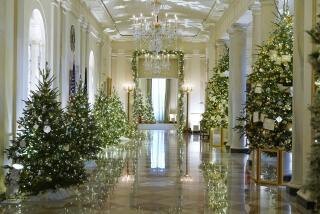The first lady’s Lincoln legacy
- Share via
Washington — Whatever election day holds for her husband, Laura Bush is about to establish her own White House legacy in a bold transformation of the Lincoln Bedroom.
When completed later this fall, the nation’s most famous guest room will retain the celebrated rosewood bed bought by Mary Todd Lincoln in 1861 as its centerpiece. Flamboyant Rococo revival furniture by renowned cabinetmaker John Henry Belter will remain. And a copy of the Emancipation Proclamation, which was signed in the room in 1863, will still be available for late-night perusal, in a glass case on a polished antique desk.
But in the first sweeping rethink of the Lincoln Bedroom in at least three decades, the timid lemon walls, celery-green curtains and pale floral carpet are being banished in favor of a blast of Victorian bliss.
Heady hues of emerald green, golden yellow and deep purple will carpet the floor, drape the windows and envelop the massive, 6-foot-tall carved headboard. Walls will be papered in a restrained palette of cream tones -- a nod to contemporary tastes -- but the pattern has been derived from the Victorian Age. Two elaborate cornices that might have topped windows in Lincoln’s day have been carved and sent to the gilders. An opulent white marble mantel was commissioned to better complement a Rococo-style mirror installed last summer.
The piece de resistance, decoratively and symbolically, will be a carved bed canopy in the shape of a crown. It too has been sent for gilding. When affixed to the ceiling, the crown will support yards of regal purple satin over white lace, both trailing to the floor.
White House curator William Allman, who detailed the project two weeks ago at a White House Historical Assn. symposium on the decorative arts, describes the decor as “back for the future.” He offered swatches of wallpaper, carpet design and historical antecedents to museum curators and decorative arts historians.
On an afternoon tour of the mansion, the second floor was off-limits. But dropcloths covered the stairway leading to the private quarters, evidence that the Lincoln Bedroom is still a work-in-progress.
“It will be very Victorian, very appropriate and very grand,” Allman assured.
He did not say how much the project would cost. But he noted that the White House Historical Assn. was providing funding, as it would for conservation of the mansion’s museum rooms.
The only room in the White House named for a president, the Lincoln Bedroom is imbued with historic importance beyond its contemporary status as coveted overnight perk.
At Bush’s behest, a panel of experts began two years ago to orchestrate a vivid re-creation of the Lincoln-era look, Allman said, with the comfort of guests driving the change.
But because the entire White House has official museum status, decorative decisions present a curatorial challenge. The Lincoln Bedroom, per se, did not exist in Lincoln’s day. So there was no way to simply replicate an earlier decor.
Today’s Lincoln Bedroom was then Lincoln’s cabinet room. The bed started out down the hall in a “Prince of Wales” guest room. Lincoln never slept in the bed, but other presidents did. Research into the guest room turned up sketches and photographs and a glowing contemporaneous account of “rich purple satin draperies adorned with lace.”
As for the Lincoln office, a search of early photographs, engravings, paintings and sketches turned up a faded image. Evidence of window cornices was found, but the original carvings disappeared in the 1930s. There is no absolute certainty, but the combination “seems reasonable” to Allman. A carpet pattern was extrapolated from mentions of a “G and O” carpet purchased by Mrs. Lincoln, which has now been translated as “green and oak.” Touches of bright yellow and purple have been added.
Gilded crowns and royal colors strike an unusual note in a house carefully stage-managed to symbolize the democracy. Neither element would have been acceptable to George Washington, who was advised to surround himself only with things that were “substantially good and majestically plain.”
The history of decorating at the White House has been one of fits and starts, power struggles, sticker shock and changing tastes. “Decorating has been a no-win situation, if one hopes to impress the foreign dignitaries while suiting the tastes of the American public,” said Leslie Greene Bowman, director of Winterthur Museum and a member of the committee overseeing the preservation.


